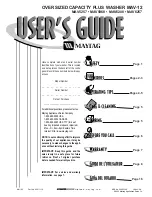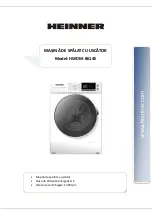
Summary of Important Safety Information
71
•
Know how to stop.
Be thoroughly familiar with proper use of the equipment and all controls and
connections. Know how to stop the pressure washer and relieve system pressure quickly if needed.
•
Danger: High-pressure fluid injection hazard
. High-pressure fluid spray or discharge from leaks
(even pin-sized) or ruptured components can pierce the skin and inject fluid into the body. Injection
injury can result in blood poisoning and/or severe tissue damage leading to infection, gangrene and
possibly amputation.
•
Check/maintain machine before each use.
Check hoses & fittings for damage and leaks before
use. Ensure all components are properly connected. Follow all maintenance instructions specified
in pressure washer and engine manuals.
-
Never operate machine with damaged or missing hoses/parts. Never attempt to repair a high-
pressure hose or component. Always replace it with a part that is rated at or above the pressure
rating of this machine.
-
Never run the machine without sufficient lubrication or sufficient water to cool the pump.
-
Never operate unless all safety guards are in place.
•
Position safely
. Place sprayer on firm, level ground to prevent accidental falls and equipment tip-
over.
•
Not in presence of combustibles
. Do not use the pressure washer in the presence of flammable
vapors, dust, gases, or other potentially combustible materials. Operate only where open flame or
torch is permitted
•
Use backflow preventer.
The use of a back-flow preventer on the water supply hose is
recommended and may be required by local code.
•
Clear work area.
Clear work area of all bystanders. Keep children and pets away.
•
Wear protective gear.
High-pressure spray can cause eye/skin injury, hot water can burn, and
flying objects/debris can cause injury. Serious injection injury can result if high-pressure spray
penetrates the skin
.
Operators should wear waterproof, thermally insulated gloves, safety glasses
with side and top protection, face protection, and protective clothing when operating the machine. If
spraying pressure washer specific cleaning chemicals, wear a respirator or mask to avoid inhalation
of vapors if directed on the chemical label.
•
Wear non-slip footwear.
Use of pressure washer can create puddles and slippery surfaces. Wear
footwear capable of maintaining a good grip on wet surfaces.
•
Check nozzle
. The nozzle can become a projectile and cause serious personal injury or property
damage if not properly connected to the spray gun. Check to ensure the nozzle has been properly
attached to the spray gun before using the pressure washer.
During use
•
Safety latch locked before starting engine.
Always engage the safety latch on the spray gun
trigger before starting the engine.
•
Incoming water supply on.
Do not run the pump without the water supply connected and turned
on. Operating the pressure washer without an incoming flow of water will damage the pump.
•
Wait before re-lighting burner.
NEVER attempt to immediately run or re-light the burner if it
doesn’t ignite the first time. Unburned fuel may have accumulated, causing potential explosion or
fire hazard.
•
Use two hands.
Pressure washer spray gun kicks back when triggered. Firmly grasp with two
hands.
•
Stay alert.
Watch what you are always doing.
•
Prevent slips / loss of balance
. High-pressure spray could cause you to lose balance from kickback
forces, and wet surfaces can be slippery.
•
Always keep good footing and balance.
•
Do not overreach.
•
Do not stand on unstable support when spraying.
•
Use extreme caution when spraying from a ladder or scaffolding, ensure it is firmly
anchored from sway or tip-over. Use extreme caution to avoid falling as spray gun kick
can propel you off the ladder or scaffolding.






































